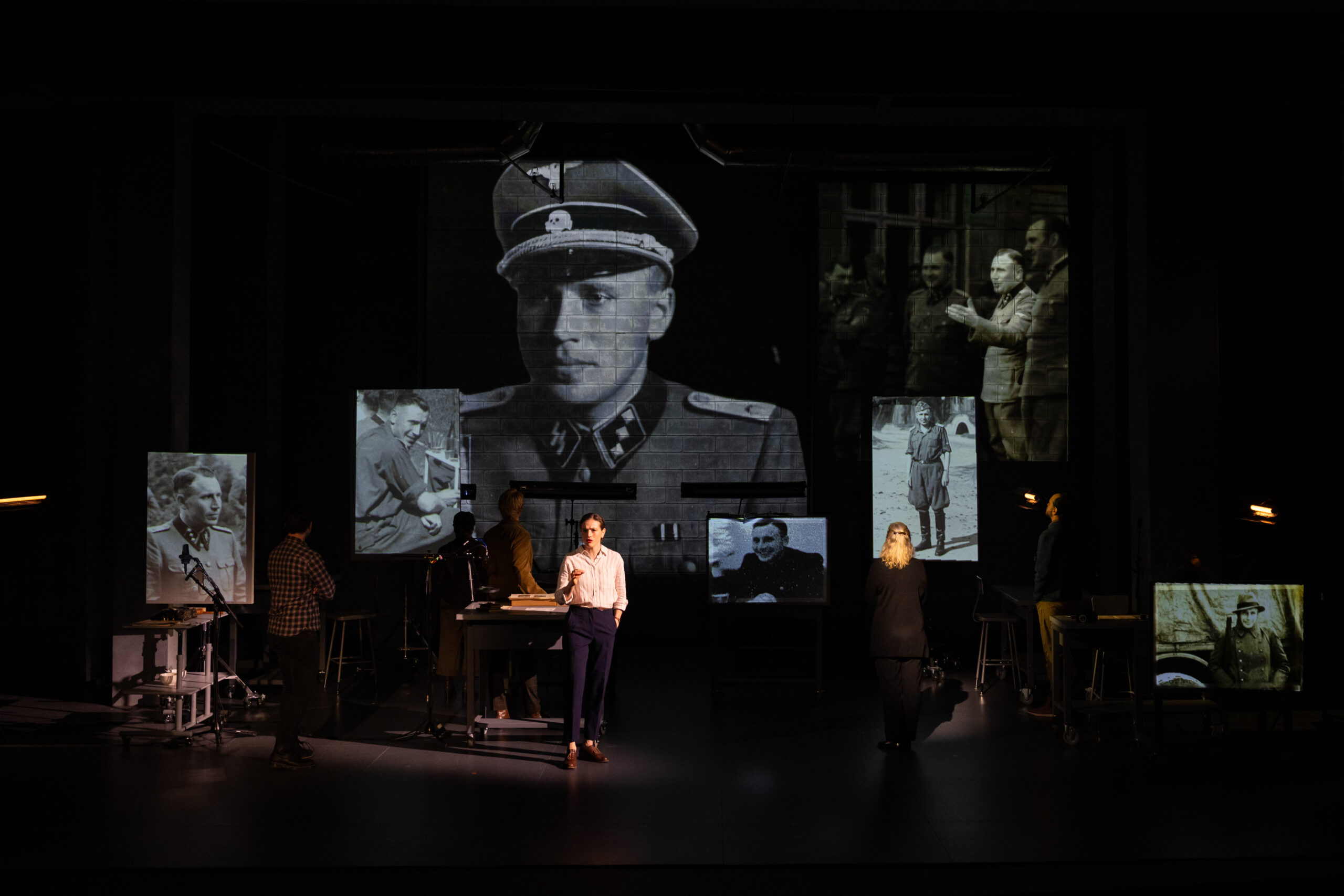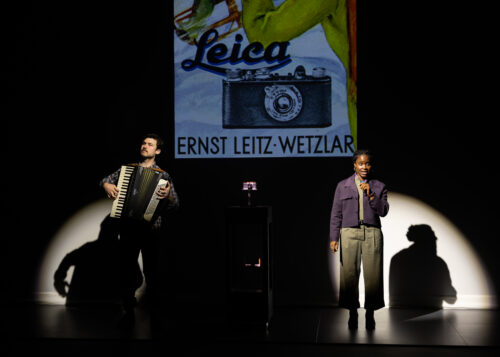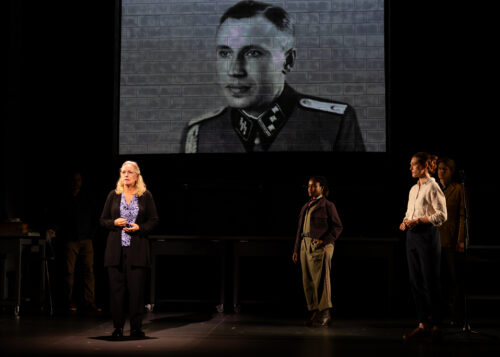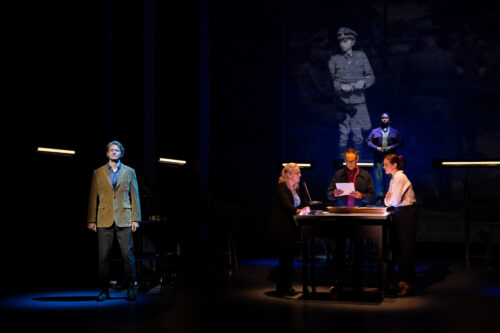Theater / Film
Review: ‘Here There Are Blueberries’ At Miami New Drama Uses Powerful Lens To Tell Story

Delia Cunningham and the cast of “Here There Are Blueberries” now playing at Miami New Drama at the Colony Theatre, Miami Beach, through Dec. 7. (Photo by Morgan Sophia Photography)
Before “Here There Are Blueberries” begins, the stage evokes a sense of nostalgia. As the audience settles in, lively 1940s music fills the air. On a small, slender table sits an object that, upon closer inspection, is revealed to be a camera—its presence confirmed by the prominent Leica logo as a backdrop.
Even before the 100-minute play begins at Miami New Drama, Moisés Kaufman and co-writer Amanda Gronich are already urging the audience to look more closely.
A man with an accordion arrives on stage. He plays bubbly German music. Then the Expert arrives to talk about the camera. “Where photography was before a cumbersome operation, available only to the few, now it was available to the masses . . . at the same time, one more factor made these cameras hugely popular . . . the pursuit of happiness.”

An accordion player (Marrick Smith) accompanies an expert (Folami Williams) as she talks about the pursuit of happiness of the Leica camera in “Here There Are Blueberries.” (Photo by Morgan Sophia Photography)
Splashes of still pictures are projected on the curtain. Larger than life black-and-white images of people frolicking, at the beach, in family photos, people with their Leica cameras. Then the large, snapshot images change, the accordion player continues the German music but there’s another sound – an ominous undercurrent. The photos change, too, children holding Nazi flags, women posed in a Nazi salute, a seemingly innocent-looking family on a couch, the two boys to the right and left doing the Heil sign.
Everything goes to black. The photos are gone, so is the accordion player, the curtain goes up and large text is projected on the brick back wall: “The play tells the story of an album of photographs, the images are real.”
Already the dichotomy has been revealed. Photos of an ordinary day-to-day existence show something happening on a deeper level.
“Here There Are Blueberries” unfolds like a forensic investigation — part lecture, part documentary, part letting us in on a secret past that has been buried – almost “Da Vinci Code”-esque.” The central object is the Höcker Album, a scrapbook like set of photographs taken by an SS officer stationed at Auschwitz. Not images of horror, but of leisure: picnics, sing-alongs, blueberry-picking afternoons. The album was mailed anonymously to the U.S. Holocaust Memorial Museum in 2007, and the play follows historians, archivists, and researchers as they piece together who the smiling people are — and what it means to look at them.
There’s another interesting connection to “Blueberries,” another focus on the past. Eight years ago, inside Miami Beach’s Colony Theatre, Miami New Drama would do the first workshop of a play, “The Album.” It was developed over several years by Kaufman (he co-founded Miami New Drama with artistic director Michel Hausmann), whose New York-based Tectonic Theater Project, specializes in documentary inspired theater. Probably Tectonic’s most well-known and most produced is “The Laramie Project” examining the aftermath of Matthew Shepard’s murder.

The primary researcher, Rebecca Erbelding (Delia Cunningham), is at the center of “Here There are Blueberries” at Miami New Drama. (Photo by Morgan Sophia Photography)
Now, “Blueberries,” fully developed and realized, is back at Miami New Drama. And the hopes of its producers is that it makes it to Broadway. It’s touring with the next stop Seattle beginning at the end of January after its run at Miami New Drama, which continues through Dec. 7.
The cast includes original Tectonic Theater Project company members who play various roles. The core of these roles are of the researchers but they do bring to life the other people who come in and out of the story.
The primary researcher, Rebecca Erbelding (Delia Cunningham), is at the center of the play. The playwrights make her the only “researcher” who plays just one other role near the end of the play. It is a dramatic choice.
Other company members who play researchers and step into other roles include Barbara Pitts McAdams as Judy Cohen, Grant Varjas as Peter Wirths, Folami Williams as Charlotte Schünzel, Kimberly Fairbanks as Melita Maschmann.
Jonathan Raviv is Tilman Taube, a German businessman who recognizes his grandfather, a doctor in a Nazi uniform, he sees in a news story about the museum obtaining the photo album. Taube is the character that carries the subplot of the story where he goes to find others who he believes should speak out about their relative’s involvement as perpetrators; Marrick Smith plays Rainer Höss and Christian Pederson is Karl Höcker, the man who sends the album to the museum.
Derek McClane’s set design puts us into a dark, almost basement-like, research lab. The researchers sit at drafting tables and look at photos through loupes (magnifiers). Dede Ayite’s costumes fit the period – 2007, workaday styles. David Lander’s lighting supports the black and white investigative tone of the play, and we feel as if we’re sharing this research space with those who become invested in digging into this album’s past.

Barbara Pitts McAdams as Judy Cohen is another researcher caught up in questions after an photo album is received by the U.S. Holocaust Museum in “Here There Are Blueberries.” (Photo by Morgan Sophia Photography)
The production’s sound design makes one of its sharpest impressions through old-fashioned, radio-play Foley. The actors create the handmade effects, at stage right behind microphones — sounds of teenage girls in photos giggling, the clink of spoons against bowls filled with blueberries. Bobby McElver’s other sounds create a murmur of off-duty life that recreate the carefree world suggested by the photographs, and tit is precisely what makes them unsettling.
Then there are the projections by David Bengali – the engine that drives “Blueberries” and create the most impact.
The projections expand the album beyond the stage, making the audience complicit in the act of viewing. The archivists narrate with a sort of professional detachment. Sometimes we may wish for more emotion, but in contemplating the choice of this detachment, it works in the context of what it is the authors want to make us feel. The idea is to, like the researchers, gather the information, then decide.
There are tension-filled moments, including when the director of the museum questions whether to put the album on exhibition. “What happens when a survivor or a descendant comes here and sees these leisure photos of the people who murdered their family members?”
Kaufman and Gronich go in and out of having the ensemble interact with one another but Rebecca many times breaks the fourth wall to speak to the audience. She’s the narrator of the story giving us piece by piece what happens, and bringing us into the emotion of what this album means – someone kept a scrapbook of the leisure activities of people whose day jobs were the extermination of people.

The ensemble plays multiple roles in “Here There Are Blueberries,” a story about a museum obtaining a scrapbook of Nazi officers’ day to day living. (Photo by Morgan Sophia Photography)
The photographs speak for themselves; the ensemble the storytellers. What happens after the lights go down is the aftermath that lingers, and that is where “Here There Are Blueberries” shows it strength. Near the end of the play, the projected images show the prisoners of Auschwitz. After the performance, a man in the lobby was close to tears. When those images appeared, he said, he found himself scanning the faces searching to see if perhaps he could see one of his own relatives.
This is the power of this play. It doesn’t just show history, it turns the lens back on us. And if you find that you’re questioning moments where you may want to look away – whether at the past or the present, that’s where “Here There Are Blueberries” proves it is a powerful piece of theater.
WHAT: Miami New Drama’s “Here There Are Blueberries”
WHERE: Colony Theatre, 1040 Lincoln Road, Miami Beach.
WHEN: Opens 7 p.m., Thursday, Nov. 13. Shows 7:30 p.m., Thursday, Friday and Saturday, Matinees, 2 p.m., Saturday and Sunday. Additional performance on final day at 6 p.m., Sunday, Dec. 7.
COST: $35-$99
INFORMATION: 305-674-1040 and miaminewdrama.org
